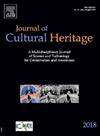Enhancing the durability of historic brick masonry: The role of diammonium phosphate and chitosan in reducing salt-induced damage
IF 3.5
2区 综合性期刊
0 ARCHAEOLOGY
引用次数: 0
Abstract
Salt crystallization represents a serious threat to historic architecture worldwide, causing structural and aesthetic damage due to the accumulation of salts in porous building materials, such as bricks. Historic masonry is particularly vulnerable to this type of damage due to the complex interactions between salts and its porous matrix. Salt crystallization modifiers have proven to be valid candidates in reducing the detrimental effects of salt crystallization within porous materials, thereby prolonging the lifespan of historic structures. In this research, chitosan was selected as crystallization inhibitor, considering his remarkable properties in terms of sustainability and cost-effectiveness. Applied to brick samples in combination with a phosphatic treatment based on diammonium phosphate, it resulted an encouraging new solution to reduce salt crystallization damage without affecting the material's properties and hence showing a good compatibility, although further research is needed to assess the effectiveness of the chitosan-based treatments for in-the-field applications.
提高历史砖砌体的耐久性:磷酸二铵和壳聚糖在减少盐致损伤中的作用
盐结晶对世界范围内的历史建筑构成严重威胁,由于盐在多孔建筑材料(如砖)中的积累,会造成结构和美学上的破坏。由于盐及其多孔基质之间的复杂相互作用,历史悠久的砌体特别容易受到这种类型的破坏。盐结晶改性剂已被证明是减少多孔材料中盐结晶的有害影响,从而延长历史建筑寿命的有效候选者。考虑到壳聚糖在可持续性和成本效益方面的优异性能,本研究选择壳聚糖作为结晶抑制剂。将其与基于磷酸二铵的磷酸盐处理相结合应用于砖样品,产生了令人鼓舞的新溶液,在不影响材料性能的情况下减少了盐结晶损伤,因此显示出良好的相容性,尽管需要进一步研究以评估基于壳聚糖的处理在现场应用中的有效性。
本文章由计算机程序翻译,如有差异,请以英文原文为准。
求助全文
约1分钟内获得全文
求助全文
来源期刊

Journal of Cultural Heritage
综合性期刊-材料科学:综合
CiteScore
6.80
自引率
9.70%
发文量
166
审稿时长
52 days
期刊介绍:
The Journal of Cultural Heritage publishes original papers which comprise previously unpublished data and present innovative methods concerning all aspects of science and technology of cultural heritage as well as interpretation and theoretical issues related to preservation.
 求助内容:
求助内容: 应助结果提醒方式:
应助结果提醒方式:


